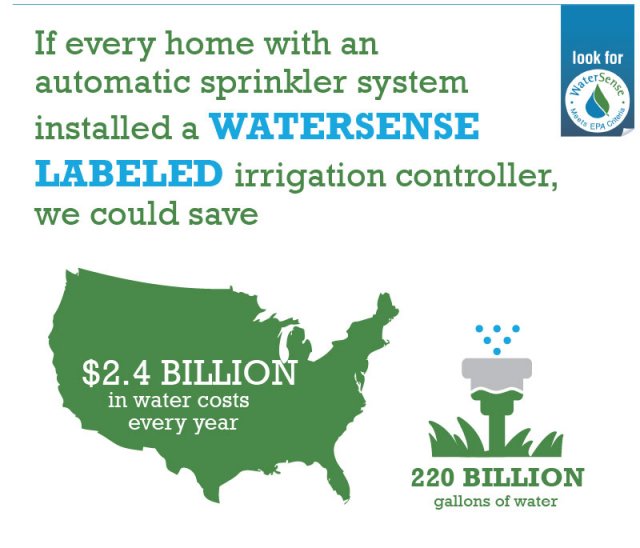Weather-Based Irrigation Controllers

WaterSense labeled irrigation controllers reduce water waste outdoors while keeping landscapes healthy. Weather-based irrigation controllers (WBICs) are one option for homeowners and businesses to achieve water-efficient irrigation scheduling. By using local weather data and landscape conditions to tailor watering schedules, weather-based irrigation controllers determine when and how much to water.
To find out more information about another option for efficient irrigation scheduling, review information on WaterSense labeled soil-moisture based irrigation controllers.
On This Page:
Smart Watering
EPA estimates that more than 28 million homes across the United States have in-ground sprinkler systems that typically schedule watering with a clock-based controller. Irrigation schedules are often set to water at the height of the growing season, and the homeowner may not adjust the schedule to reflect seasonal changes or changes in plant watering needs. As an alternative to a clock-based controller, weather-based irrigation controllers can make irrigation schedule adjustments more convenient and water-efficient, by using local weather data and landscape conditions to tailor the amount, frequency, and timing of landscape watering. Weather-based irrigation controllers can be stand-alone controllers or “add-on” or “plug-in” devices that can be used in conjunction with an existing clock-based controller to help it water more efficiently.
To earn the WaterSense label, weather-based irrigation controllers must be able to adequately meet the watering needs of a landscape without overwatering. As with all other WaterSense labeled products, WaterSense labeled weather-based irrigation controllers are independently certified to ensure that they meet the U.S. Environmental Protection Agency’s (EPA’s) criteria for efficiency and performance.
For more detailed information on WaterSense labeled weather-based irrigation controllers, their benefits and function, read the WaterSense Labeled Weather–Based Irrigation Controller Mini Report (4 pp, 2 MB, About PDF).
WaterSense Savings

Replacing a standard clock-based controller with a WaterSense labeled weather-based irrigation controller can save an average home nearly 7,600 gallons of water annually. If every home in the United States with an automatic sprinkler system installed and properly operated a WaterSense labeled controller, we could save $2.5 billion in water costs and 220 billion gallons of water across the country annually from not overwatering lawns and landscapes. Some utilities offer rebates to help you water smarter outdoors.
Performance
Weather-based irrigation controllers were the first irrigation product to be considered by WaterSense, and at the time were not subject to national or voluntary product standards. WaterSense worked with the University of Florida to conduct two rounds of research to validate an existing test method, the Smart Water Application Technologies® test protocol for climatologically-based controllers (SWAT protocol), that it could reference to assess product performance. From the validation, WaterSense identified modifications that were needed to generate reproducible results in regions across the country. The WaterSense specification test method has since been adopted into a consensus-based standard, ANSI/ASABE S627 Weather-Based Landscape Irrigation Control Systems.
WaterSense labeled products are independently certified to meet the performance criteria in the following areas to ensure the watering needs of a landscape are met without overwatering.
- Irrigation adequacy: Provides an indication of the controller’s ability to meet plant water needs.
- Irrigation excess: Evaluates the controller’s ability to avoid excess watering.
- Supplemental capability requirements: Ensures the presence of additional features (e.g., ability to accommodate watering restrictions) to ensure greater long-term water savings.
See the Performance Overview for more information on how WaterSense assessed performance when developing the specification.
- WaterSense Performance Overview: Ensuring Products Perform (pdf)
- WaterSense Performance Overview: Weather-Based Irrigation Controllers (pdf)
Specification
In September 2021, EPA released a revised version of the WaterSense Specification for Weather-Based Irrigation Controllers (Version 1.1). The revisions to the specification are minor and clarify the existing requirements for a weather-based irrigation controller to earn the WaterSense label. The changes also reflect the December 2020 publication of the American National Standards Institute (ANSI)/American Society of Agricultural and Biological Engineers (ASABE) Standard S627, Weather-Based Landscape Irrigation Control Systems, which is consistent with the performance test method included in Version 1.0 of the WaterSense Specification for Weather-Based Irrigation Controllers.
- WaterSense Specification for Weather-Based Irrigation Controllers, Version 1.1 (pdf)
- Summary of Revisions to the WaterSense Specification for Weather-Based Irrigation Controllers (pdf)
- Supplemental Guidance for WaterSense Certification and Labeling of Weather-Based and Soil Moisture-Based Irrigation Controllers (pdf)
Please note: WaterSense has prepared software that the licensed certifying bodies will use to administer the performance test protocol as described in the specification. Manufacturer partners may request a copy of the software by contacting the WaterSense Helpline at watersense@epa.gov or (866) WTR- SENSE (987-7367). The Helpline cannot provide technical support for the software. EPA only provides technical support for the software to its licensed certifying bodies as part of the certification process.
Version 1.1 of the WaterSense Specification for Weather-Based Irrigation Controllers replaces Version 1.0, which EPA released November 3, 2011. For more information about the WaterSense specification development process for weather-based irrigation controllers, please visit the Background Materials page.
Manufacturers that produce weather-based irrigation controllers meeting EPA's efficiency and performance criteria can apply to have their products certified to earn the WaterSense label. Before submitting products for testing, manufacturers must have a signed WaterSense partnership agreement with EPA in place. Visit the manufacturer section on the partner page to learn more.

